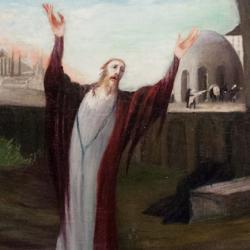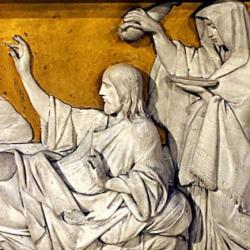In a 2005 article in JSNT, J. David Hester challenges the view that Jesus’ eunuch saying in Matthew 19:12 is an endorsement of celibacy. Part of his argument rests on an analysis of ancient conceptions of eunuchs, who were regularly feared because they confused gender distinctions. Eunuchs must be understood, he argues, against the background of ancient concepts of masculinity, in which male virtue is associated with power and dominance, expressed in violence and sexual mastery. A eunuch was not an ascetic, but a strangely unmanly man.
Hester notes,
“The Greek had approximately seven terms used in semantic relation to ‘eunuch’, and the Romans had even more, all of which were based on various technologies of castration. This variety of terms was compounded by the varying results of different kinds of castration, as well as the effect of castration upon prepubescent versus post-pubescent males. With respect to prepubescent castration, certain physiological characteristics were widely known and stereotyped, including feminine and beardless faces, physical weakness, height, with womanish vocal characteristics. With respect to post-pubescent castration, however, many secondary sex-characteristics associated with males would be maintained, making it extremely difficult for anyone in the ancient world to know for certain whether the man in front of him was a eunuch or not.
“The confusion that eunicism created made the eunuch a particular lightning rod for male anxiety and an object of tremendous suspicion, particularly with respect to their morality. Generally, they were viewed as soft (mollis, eviratus), effeminate (semivir, semimas, effeminatus), sexually passive, unkind, immodest (impudieitia), ‘changeable,’ ‘light-skinned,’ weak, impotent, deceitful, cowardly and incapable of virtue. Popular novels depicted them as power-seeking, unscrupulous, greedy, untrustworthy and undependable. Achreia attributed to Diogenes had him commenting upon an inscription over the door of a house of an ‘evil eunuch’ that said, ‘Let nothing evil enter’ by responding, ‘How can the owner then enter?’ Dream interpretation, popular sayings, fables, even popular superstitions, all viewed the eunuch as an object of scorn, bad luck and deception. The eunuch, by definition, was not (could not) be a morally upright and virtuous figure, but was always suspicious.”
Philo interprets the laws prohibiting eunuchs from serving as priests and from entering the congregation of Israel in the same fashion: “Eunuchs are precluded from entering the congregation because ‘they belie their sex and are affeeted with effemination, [they] debase the currency of nature and violate it by assuming the passions and the outward form of licentious women. For [the Law] expels those whose generative organs are fractured or mutilated, who husband the flower of their youthful bloom, lest it should quickly wither, and restamp the masculine cast into a feminine form.”
Hester also points to evidence of ritual castration in some ancient religious cults: “Regardless of the variations among myths, religious rites were well known: in springtime devotees to Cybele/Magna Mater would engage in ecstatic dancing. Certain novice members who were ready to signal their complete devotion would then take the ritual curved stone knife and castrate themselves, flinging their now amputated testicles at the door of the house, whose female members were then expected to give them clothing, which they would then don. This would be followed by a time of lamentation eventually giving way to celebration.”
Christians too early on adopted the practice, literally making themselves eunuchs for the kingdom: “Throughout Christian and European history there have been those who took and taught this statement literally: Valentinus (whose sect was centuries later declared heretical; mid-second century), Julius Cassianus (also declared heretical; also mid-second century), Basilides (also declared heretical; early-second century), Leontios of Antiochia (Bishop of Jerusalem; late-fourth century), Melito ‘the Eunuch’ (c. late-second century), Hilarion (mid-fourth century), Marcarius ‘the Egyptian’ (late-fourth century) and Origen (also declared heretical; early third century) are among the most famous of thousands that chose ritual castration. Several early Christian encratite and ascetic movements (centered mainly in Egypt) are known to have members among whom were numbered eunuchs.”
Orthodox Christians, he says, turned to an allegorical reading of Matthew 19:12 in order to head off this sort of devotion. That accounts for its setting in Matthew, where it is embedded in a debate about marriage and divorce. But that, he claims, loses the radical import of the saying: “Regardless of whether the eunuch is understood either as (1) an outcast from the community of believers as suggested by the Deuteronomic author, (2) a transgressor of cultic purity premised upon male privilege and clear delineation of male/female roles as suggested by first-century Jewish moralists, (3) a monstrous liminal sex-gender intermediary suffering from the disease of effeminacy with all its sexual and moral depravity as suggested by early Christian apologists, or even (4) a metaphorical figure of askesis that renounces human sexuality and family kinship obligations as suggested by Matthew and later Christian apologists, this logion of Jesus questions the privileged position of a heterosexist binary paradigm of identity. No matter how you view it, the figure of the eunuch as both a physical body and a social identity radically undermines the foundational assumptions used to reinforce the conservative heterosexist reading of the Bible, precisely because this body and this social identity threatens the sacred boundaries between male and female. The kingdom of heaven resides in between, even outside this dichotomy in the ultimate ancient figure of sex-gender transgression.”
Some of this is certainly true: This is one of those sayings that radically relativizes family and kin, and the Jewish emphasis on descent and blood. But Hester wants to use this passage in the service of a pro-homosexual interpretation. It undermines the “binary” of male and female: “The implications of this reading are quite radical, because the logion is suggesting that sex-gender transgression is a biblically sanctioned identity practice. Any Christian sexual ethic that seeks to ground itself by appeal to a scripturally based warrant for a heterosexist imperative must confront the specific rejection of this imperative in this logion. At its heart, the eunuch is a figure that stands outside ofthe binary sex paradigm.”
Hester can make his case, however, only by detaching the passage from its place in Matthew, which is the only setting we have for the saying. And in this context, Jesus has explicitly endorsed the “binary” of male and female (19:4) and the created pattern of marriage between man and woman (19:5). In the end, Hester’s article, for all its interesting and important historical information, is another demonstration of the massive ethical consequences of critical scholarship.











